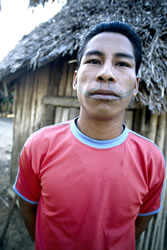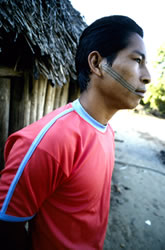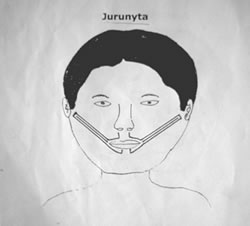The Jawosi and Initiation
Amidst throngs of whooping and frenzied male admirers, the victorious Kayabi warrior moved closer to the community hut in the center of the village. By the time he reached this location, preparations for the most important of Kayabi rituals was well underway; the Jawosi war ritual was about to begin.
The Kayabi told me that in order to understand the Jawosi ritual, I not only needed to understand life, but I also needed to contemplate death and to think about how to get over periods of sadness experienced by the personal loss of a close relative. This, I said, would not be too difficult for me, since I lost my mother last year to a long “battle” with cancer and experienced the death of my best friend.
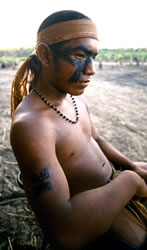 |
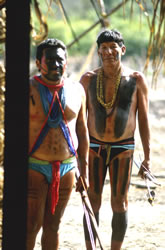 |
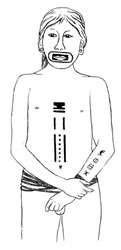 |
Before this Kayabi initiate received the frog tattoo from Kurapi on his arm, the shaman Tuiarajup (at right) contacted his spirit helpers called ma’it. “With their help and a bit of tobacco smoke, I have to ward off all of the evil spirits in the vicinity so that they do no harm. These evil spirits live at the horizon, in the mountains, and in all of those areas where white men have destroyed the environment, killed animals, or have done harm to people. This is where evil spirits are lurking,” he said.
Tuiarajup’s helper spirits also provide him with the name and design of the initiate’s tattoo: “This name and its associated design must be respected; otherwise it will bring grave danger or even death to the wearer.” Photographs © Lars Krutak 2007-2010
|
Early 20th century tattoo drawing depicting traditional Kayabi name glyphs on forearms obtained through the dreams of old shamans. These tattoos were also applied to the legs and chest. |
Today, the Jawosi is celebrated to: (1) end periods of mourning; (2) to celebrate the arrival of visitors or of hunters back to the village or; (3) to mark the beginning of male initiation. Yet when warfare and headhunting were still practiced several decades ago, elements (1) and (3) were combined together to celebrate the return of victorious Kayabi headhunters to the village.
|
|
Most of the songs that were sung during the Jawosi focus on the heroic deeds of valiant warriors and their encounters with indigenous enemies, as well as with “whites,” and were often generated by the singers’ own experiences in war or travel to the battlefield. In the village of Capivara where I lived with 200 Kayabi, these songs or “war stories” continue to be sung having been passed down through the generations. Even though there are no more wars or enemy heads, the Kayabi have returned to the ritual with a few substitutions (e.g., monkey skulls have replaced human skulls) in the context of a cultural renaissance, because they are afraid of losing touch with their ancestral traditions like other Amazonian peoples. |
As noted, many years ago the Jawosi was held to not only celebrate the death of an enemy, but to also prepare a new generation of Kayabi initiates to become men. Before the boys could complete this important rite of passage, however, they had to undergo a lengthy period of seclusion in their father’s hut. Otherwise, they were not allowed to become warriors, receive tattoos, or marry.
Prior to their seclusion, weeks of communal dancing in the community hut at the village center were observed, and all of the Kayabi living in surrounding villages came to pay their respects and to participate. Every song that was sung by elder men during the Jawosi dances directed the initiates on how to live, and how to face life’s challenges by confronting death through recounting war stories and being face to face with the enemy. These songs did this by specifically referencing the mythic deeds of the ancestors, of culture heroes, of slain enemies and relatives, and even evil spirits who lurked in the jungle. Oftentimes these songs resembled speeches and were studded with much metaphorical language. For example, “arrows” stood for relatives; sounds of fish = the sounds of the enemy; chopping down trees = killing an enemy; losing an arrow or axe blade = losing a relative in battle; making the kawi (manioc beer) beverage = boiling an enemy’s head to extract its teeth for a necklace (note: these were given to the pajé or village shaman who wore them for spiritual power).
More or less, Jawosi songs focused on changing peoples’ perspectives on death, about showing how the deaths of others (enemies and even family members) have the potential to bring new life by creating a new generation of Kayabi “men” through initiation. But the ritual was also about human fertility as well. Just as the Jawosi was beginning, an enemy skull had been boiled and its flesh removed. The skull was then brought out to the initiates so that they could touch the head or crush the skull with a war club. Once the initiates did this, they had to go into seclusion in their father’s home because they had “changed blood”; a process that could endanger them but that could also render them more fertile.
During seclusion, the male elders of the family taught the initiates not only how to become warriors, hunters, husbands, and fathers, but also how to become leaders, public speakers, and knowledgeable adults. They were commanded to listen to everything their male relatives taught them, and for this reason their ears were pierced with the thorns of the tucum palm so that they would “listen well”. It is said that if the boy lost one of these thorns during his seclusion, that ear would be chopped off as punishment!
While in seclusion, the initiates also observed various taboos and food restrictions which reduced the “poisoning” effects of contact with the enemy’s blood that “had filled them.” In turn, after all of the ritual precepts and obligations had been met, and only after another enemy head was brought back into the village to complete the ritual period of seclusion, the initiates would then emerge and be given new names that were tattooed on their bodies to mark them as fully fledged members of Kayabi society. In some sense, this baptism in enemy blood, and the tattooing which followed, seems to have been the necessary precondition for which each initiate had to experience in order to attain adulthood.
Next Page | 1
|
2 |
3 |
4 |
5 |
6 |
7 |
8 |
Museum photo gallery of the images
on this page may be seen here. |




